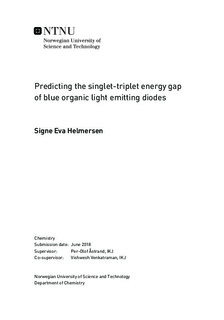Predicting the singlet-triplet energy gap of blue organic light emitting diodes
Master thesis
Permanent lenke
http://hdl.handle.net/11250/2564448Utgivelsesdato
2018Metadata
Vis full innførselSamlinger
- Institutt for kjemi [1352]
Sammendrag
Structural and experimental data for 60 different blue emitting dyes were collected from a recent review paper. Various 3D molecular descriptors based on energies, charges and geometry were calculated using KRAKENX and used to identify quantitative structure-property relationships (QSPR) for the singlet-triplet energy gap. Exploratory analysis using principal component analysis (PCA) and k-means cluster analysis were performed to observe the variance in the data and to detect patterns and potential outliers. Partial least squares regression (PLSR) and the non-linear regression tree method Cubist was used to create models for estimating the singlet-triplet energy gap. The best results were obtained with Cubist, indicating that there is a non-linear relation between the descriptors and the singlet-triplet energy gap. The best model had a cross-validated correlation coefficient of 0.59 and a RMSE of 0.08 with variable selection performed. The data used in this thesis proved to be highly heterogeneous, which resulted in a insufficient coverage of the chemical space. An attempt was made to calculate the singlet-triplet energy gap using TDDFT on a selected set of structures. The computation was unfortunately not completed due to time constraints and problems with convergence.
